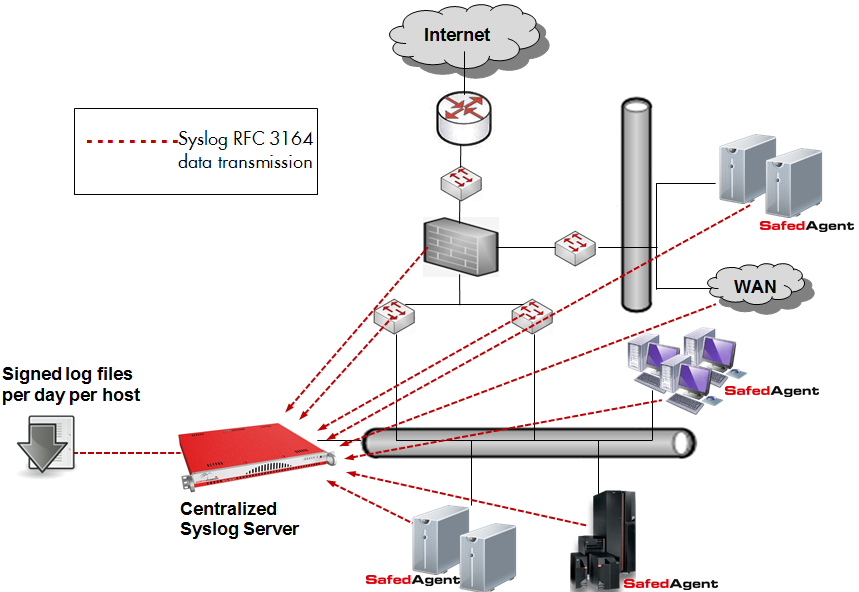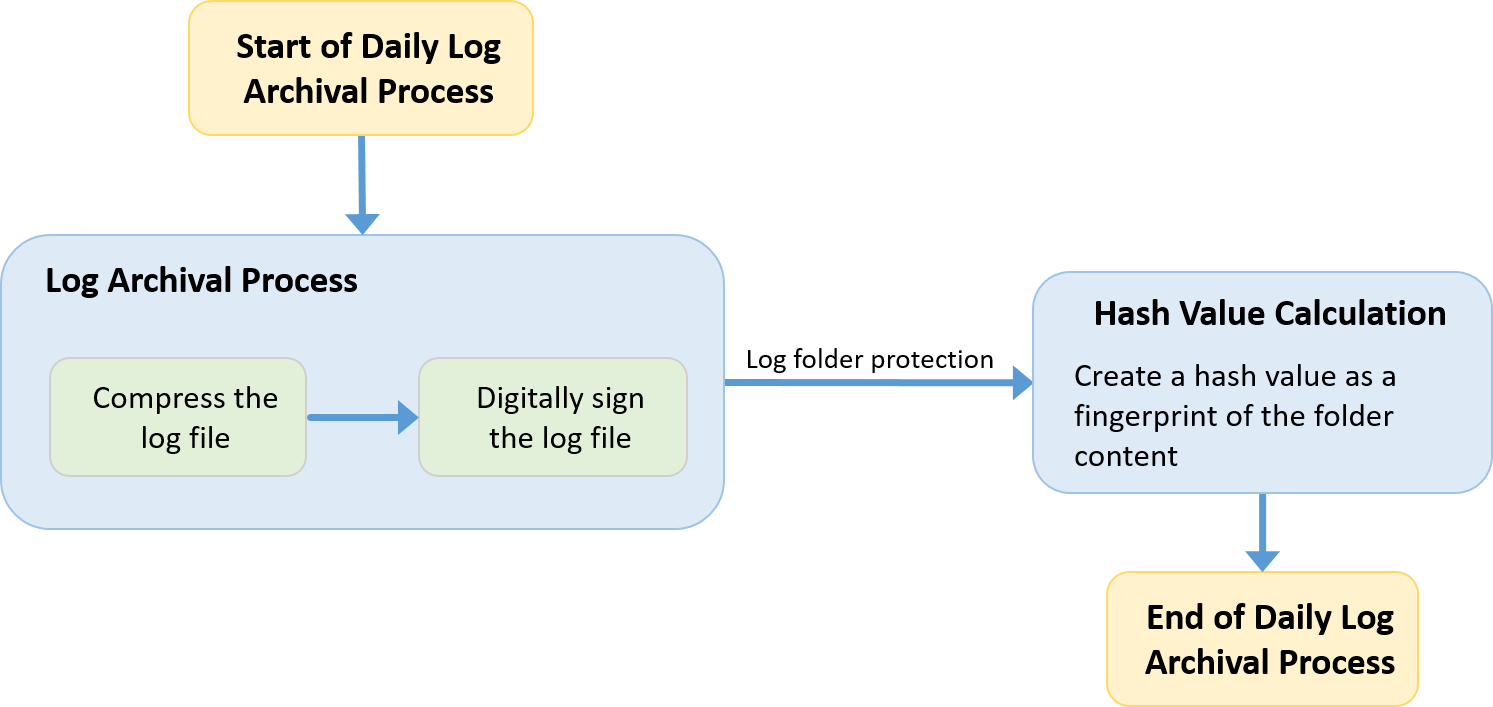How Log Manager Works¶
NetEye uses rsyslog as the underlying log auditing data collector. Rsyslog is an Open Source software utility used on Unix and Unix-like computer systems for forwarding and collecting log messages. It implements the basic syslog protocol RFC 3164, extends it with content-based filtering, rich filtering capabilities and flexible configuration options, and adds important features such as using TCP for transport.

Fig. 206 The Log Manager system architecture¶
Rsyslog as a Data Collector¶
Most embedded devices (routers, switches, firewalls, etc.) support the transmission of syslog data via the RFC 3164 protocol, allowing the data to be collected by rsyslog. Systems based on Windows, Linux, AIX, HP-UX, and Solaris must instead use other agents to fulfill these needs. NetEye’s Safed Agent combines the functionality of Snare and Epilog to guarantee interoperability with rsyslogd and syslog-ng, and uses open protocols to allow integration with other centralized Syslog Servers.
- The Safed Agent extends the functionalities of other open source agents:
Better reliability for data transmission
Efficient CPU usage
Improved security through TLS, HTTPS, and access control
Optimized and centralized agent configuration
A larger number of supported platforms
Improved filtering efficiency
Auto discovery of administrators
A single agent for all systems: Windows XP, Windows Vista, Windows 7, Windows Server 2000, Windows Server 2003 (32 – 64 Bit), Windows Server 2008, Windows Server 2008 R2, IBM-AIX, HP-UX, Solaris, and Linux (Debian, RedHat, SUSE, Ubuntu, etc.)
Log Manager Concepts¶
Role Distinction: System Administrator vs. Logging Supervisor
One of the principle concepts of the legally clean implementation of the central NetEye logging facility is the distinction between an internal system administrator and the person in charge of system logging (the logging supervisor). The security and protection of the log server configuration can only be proven to be unaltered (a legal requirement) if the log server configuration cannot be accessed by the system administrator. This is why the NetEye Log Manager web frontend comes with a dedicated, separate role determining access to the configuration section.
Syslog Server Access Restriction
Following the above reasoning, the syslog server itself must not only be protected physically from being accessed by system administrators, but also by password. If the NetEye monitoring service is also running on the same server, then access can be granted through dedicated permissions. (This avoids the need of providing the universal and unlimited access that a root user has).
Security and Integrity Validation
Log Manager provides for the following set of legally required characteristics:
Verification that log date and date of last modification on the system are equal.
The signature of the log file exists and that the signature checksum recalculation matches the current content of the log file.
The timestamp of the signature corresponds at most to only one day after the date when the log files were collected.
Folder integrity check: A SHA512 checksum is calculated over the whole folder for a single day, and stored in the archive of the next day. This initiates a chain of trusted integrity. Together with the checksum of the previous day, the hash of the next day’s checksum is then calculated. ANY modification of the SHA512 file would lead to corruption on the hash result for the next day, and the same for ANY modification of any log file and their signatures.
Monitoring checks are performed to determine whether the Safed Agent is running and is reachable on the remote system.
For Windows-based hosts, checks can be run for automatic detection and registration of users making up the AD administrators group.
The process of daily log archiving can be described in the flowchart in Fig. 207:

Fig. 207 Daily log archiving process¶
Technical Overview¶
The Syslog server runs as a service and collects the incoming log messages, based on custom filter and host rules, into a defined folder architecture on the local file system. The folders where the log files are stored have the following structure:
Year
Month
Day
hostname-hostip.log
Each individual log file is filled during the day with incoming log messages. Then at the end of the day, this log file is compacted to optimize the space used on disk and signed with an installation-specific private key in order to freeze the log file content and the current timestamp in a signature file. This ensures that any modification to the file can be detected because the signature will be invalidated, and that any signature re-created after the day the log file was made can be discovered.
By default, in the Monitoring module there are two services that check respectively the retention policy and the blockchain integrity of the Log Manager files. Each service check reads the verification output from a cache that is periodically updated (Log Integrity Checks); in case of errors, the plugin output reports the timestamp of the last verification execution.
A user can run the dedicated icingacli verify command and force
it to read from cache (both for retention policy and for integrity
verification) just adding the --cache option to it. For further
details use:
icingacli logmanager consistency verifyBlockChain --help
icingacli logmanager retentionpolicy verify --help
To carry out recurrent tasks, two systemd timers are made available within the Log Manager module and are activated during the installation:
icingaweb2-module-logmanager-retention.timer. This timer launches the command
icingacli logmanager retentionpolicy applyexactly at midnight; its purpose is to verify if the retention time for log files has been exceeded and applies the defined policy.icingaweb2-module-logmanager-extend-blockchain.timer. The purpose of this timer is to build a blockchain for the log files saved on NetEye.
The NetEye Log Manager module also allows you to define server-based filter and exclusion rules to optimize and restrict the content of logged strings. Normally it would be better to already filter unnecessary log content on the remote systems where the log stream is generated in order to reduce network traffic and server processing time. However, this is not always possible due to system and application restrictions.
While it can be done for application-specific log content, this might get more tricky if, e.g., the EventLog of a Microsoft system is read out. Then there could be events with the same Event ID where some of those events are of interest and others are not. In those cases where you can’t precisely filter all the required log strings on the remote system, the NetEye Log Manager lets you define custom filters based on white and/or black lists.

